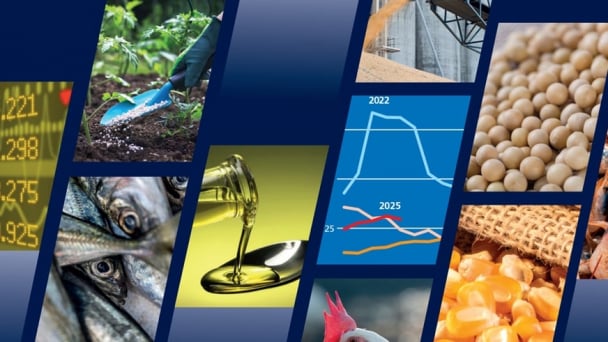June 18, 2025 | 10:43 GMT +7
June 18, 2025 | 10:43 GMT +7
Hotline: 0913.378.918
June 18, 2025 | 10:43 GMT +7
Hotline: 0913.378.918

CBOT corn futures and January USDA reports.
Chicago corn futures have ticked slightly lower to start the year, but they had climbed nearly 12% in the final two months of 2024, an unusually strong late-year run.
Speculators now hold their most bullish corn view in two years, and luckily for them, the trade has already accepted that last year’s U.S. corn yield was a whopper.
Friday will feature USDA’s biggest data release of the year, with primary focus on the most recent U.S. corn and soybean harvests. U.S. quarterly stocks, U.S. winter wheat seedings and routine global supply and demand updates will also compete for attention.
On average, analysts peg U.S. corn yield at 182.7 bushels per acre, down from 183.1 in November. The trade estimate is more than 5 bushels above last year’s record and above USDA’s initial trendline yield for the first time in six years.
Bearish yield outcomes are less likely when the estimates are already large, and only four of 19 polled analysts see corn yield rising from November. However, the range of trade estimates (2.4 bpa) is smaller than usual, flagging the potential for surprise.
In the last decade, analysts anticipated the wrong direction of U.S. corn yield in January only once (2019). They did so three times for soybean yield (2016, 2019, 2022).
But bets are somewhat off for U.S. soybean yield outcomes because USDA’s slashing of the forecast in November was the month’s largest cut in 31 years. Trade estimates indicate some uncertainty around U.S. soybean production as the ranges for both yield and harvested area are historically wide.
Regardless, U.S. soybean supplies are expected to remain ample and at multi-year highs. However, USDA last month pegged 2024-25 U.S. corn ending stocks below the prior year’s level for the first time.
If USDA cuts U.S. corn ending stocks on Friday as expected, it would be the agency’s seventh consecutive monthly reduction. Such a streak has not been observed in at least two decades, reflective of the strong demand that has recently lifted corn prices.
From a market reaction standpoint, these demand dynamics could be somewhat insulating if the U.S. corn crop comes in larger than expected. The last two times CBOT corn had a distinctly negative reaction on January report day were 2012 and 2024, the latter sparked by a huge yield above all trade estimates.
USDA will not officially issue 2025-26 outlooks until May, but the wheat market will receive its first piece of 2025-26 U.S. crop intel on Friday with the winter wheat planting survey. Total U.S. winter wheat acres are pegged at 33.37 million, very close to both last year and the five-year average.
Analysts have had a rough time anticipating the planting survey in the last two years, coming in almost 1.4 million acres too high last year but lowballing by nearly 2.5 million acres in 2023.
Wheat traders have struggled to find viable bullish narratives despite wheat stocks among major exporters seen dropping to 17-year lows, so another big miss in the U.S. wheat acreage could either support or undermine the recent sentiment.
The U.S. crops will probably dominate the headlines on Friday, but it is not too early to watch out for forecast changes in South America. Analysts see USDA upping Brazil’s 2024-25 soybean harvest to a record 170.28 million metric tons from the previous 169 million.
USDA has increased Brazil’s soy crop in three of the last eight Januarys, both on area and yield improvements, and many industry participants have already been factoring in a number north of 170 million tons.
For Argentina, there are already fears that ongoing dry weather could eventually warrant more significant cuts to soybean and corn crops than are anticipated for Friday. American and European weather model runs on Thursday remained stingy with the rainfall over the next two weeks.
USDA already hiked Argentina’s soybean output last month on higher area. The agency increased the crop last January but reduced it in the prior three Januarys. Current crop conditions are slightly worse than a year ago but better than in the prior three years.
(Reuters)
/2025/06/17/2344-1-131758_261.jpg)
(VAN) Amid tariff risks and growing trade barriers in the U.S. market, Australia is emerging as a promising destination to sustain the growth momentum of Vietnam's shrimp exports.
/2025/06/17/2013-1-nongnghiep-112009.jpg)
(VAN) This notable growth trend reflects the global taste for fresh, nutritious fruits and the expanding use of lychees across various sectors.

(VAN) The political and cultural insulation of Japan’s beloved grain is falling apart, and experts warn the country’s relationship with the staple will have to adapt.

(VAN) Noting risks, report examines impacts of avian influenza, changing trade patterns since 2022, fish fraud, and shipping industry’s net-zero goals.

(VAN) Mr. Tran Quang Bao, General Director of the Forestry and Forest Protection Department, met and worked with the International Wood Products Association to promote cooperation in the field of timber trade.

(VAN) China's outbound shipments of rare earths in May jumped 23% on the month to their highest in a year, though Beijing's export curbs on some of the critical minerals halted some overseas sales.

(VAN) To sustain capital flow, administrative reform alone is not enough; what farmers truly need is an ecosystem where both government and businesses grow together in support.